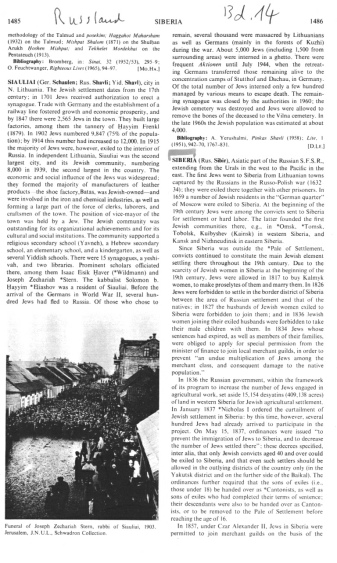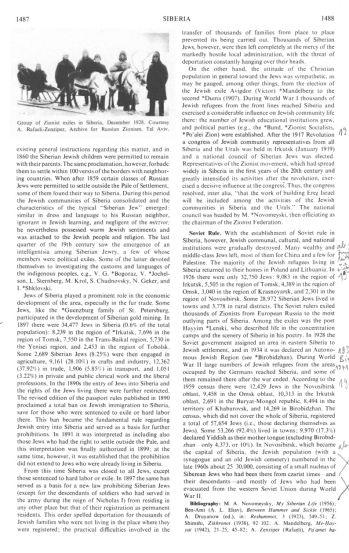Deported and exiled Jews since 1634 - restrictions - mass flight to Siberia during WW I and WW II - "Soviet" law against Herzl Zionism
from: Siberia; In: Encyclopaedia Judaica 1971, vol.14
presented by Michael Palomino (2008)
| Teilen
/ share: |
Facebook |
|
Twitter |
|
|
|
[1634: Lithuanian Jews deported to Siberia - 1659: exiled Jews from Moscow]
<SIBERIA (Rus. Sibir), Asiatic part of the Russian S.F.S.R., extending from the Urals in the west to the Pacific in the east. The first Jews went to Siberia from Lithuanian towns captured by the Russians in the Russo-Polish war (1632-34); they were exiled there together with other prisoners.
In 1659 a number of Jewish residents in the "German quarter" of Moscow were exiled to Siberia.
[19th century: forced labor for Jews in Siberia - Jewish communities founded in Siberia]
At the beginning of the 19th century Jews were among the convicts sent to Siberia for settlement or hard labor.
The latter founded the first Jewish communities there, e.g., in *Omsk, *Tomsk, Tobolsk, Kuibyshev (Kainsk) in western Siberia, and Kansk and Nitzhneudinsk in eastern Siberia.
[19th cent.: Jewish women in Siberia from Kalmyk women - forbidden areas - forbidden contacts]
Since Siberia was outside the *Pale of Settlement, convicts continued to constitute the main Jewish element settling there throughout the 19th century. Due to the scarcity of Jewish women in Siberia at the beginning of the 19th century, Jews were allowed in 1817 to buy Kalmyk women, to make proselytes of them and marry them.
In 1826 Jews were forbidden to settle in the border district of Siberia between the area of Russian settlement and that of the natives;
in 1827 the husbands of Jewish women exiled to Siberia were forbidden to join them;
and in 1836 Jewish women joining their exiled husbands were forbidden to take their male children with them.
[Integration of Jews after the sentence - special permits necessary]
In 1834 Jews whose sentences had expired, as well as members of their families, were obliged to apply for special permission from the minister of finance to join local merchant guilds, in order to prevent "an undue multiplication of Jews among the merchant class, and consequent damage to the native population."
In 1836 the Russian government, within the framework of its program to increase the number of Jews engaged in agricultural work, set aside 15,154 desyatins (409,138 acres) of land in western Siberia for Jewish agricultural settlement.
[1837: Restricting immigration law for Jews to Siberia - Cantonist law against Jewish children]
In January 1837 *Nicholas I ordered the curtailment of Jewish settlement in Siberia: by this time, however, several hundred Jews had already arrived to participate in the project. On May 15, 1837, ordinances were issued "to prevent the immigration of Jews to Siberia, and to decrease the number of Jews settled there"; these decrees specified, inter alia, that only Jewish convicts aged 40 and over could be exiled to Siberia, and that even such settlers should be allowed in the outlying districts of the country only (in the Yakutsk district and on the further side of the Baikal).
The ordinances further required that the sons of exiles (i.e., those under 18) be handed over as *Cantonists, as well as sons of exiles who had completed their terms of sentence; their descendants were also to be handed over as Cantonists, or to be removed to the Pale of Settlement before reaching the age of 16.
[1857: Permission to join merchant guilds - 1860: family law - some assimilation - trade activities]
In 1857, under Czar Alexander II, Jews in Siberia were permitted to join merchant guilds on the basis of the (col. 1486)
existing general instructions regarding this matter, and in 1860 the Siberian Jewish children were permitted to remain with their parents. The same proclamation, however, forbade them to settle within 100 versts of the borders with neighboring countries. When after 1859 certain classes of Russian Jews were permitted to settle outside the Pale of Settlement, some of them found their way to Siberia. During this period the Jewish communities of Siberia consolidated and the characteristics of the typical "Siberian Jew" emerged: similar in dress and language to his Russian neighbor, ignorant in Jewish learning, and negligent of the mitzvot [[commands]]; he nevertheless possessed warm Jewish sentiments and was attached to the Jewish people and religion. The last quarter of the 19th century saw the emergence of an intelligentsia among Siberian Jewry, a few of whose members were political exiles. Some of the latter devoted themselves to investigating the customs and languages of the indigenous peoples, e.g., V.G. *Bogoraz, V. *Jochelson, L. Sternberg, M. Krol, S. Chudnovsky, N. Geker, and I. *Shklovski.
Jews of Siberia played a prominent role in the economic development of the area, especially in the fur trade. Some Jews, like the *Guenzburg family of St. Petersburg, participated in the development of Siberian gold mining. [...]
[1890s: Further restrictions - Siberia as exile and hard labor land - bans and possibilities]
In the 1890s the entry of Jews into Siberia and the rights of the Jews living there were further restricted, proclaimed a total ban on Jewish immigration to Siberia, save for those who were sentenced to exile or hard labor there. This ban became the fundamental rule regarding Jewish entry into Siberia and served as a basis for further prohibitions.
In 1891 it was interpreted as including also those Jews who had the right to settle outside the Pale, and this interpretation was finally authorized in 1899; at the same time, however, it was established that the prohibition did not extend to Jews who were already living in Siberia. From this time Siberia was closed to all Jews, except those sentenced to hard labor or exile. In 1897 the same ban served as a basis for a new law prohibiting Siberian Jews (except for the descendants of soldiers who had served in the army during the reign of Nicholas I) from residing in any other place but that of their registration as permanent residents. This order spelled deportation for thousands of Jewish families who were not living in the place where they were registered; the practical difficulties involved in the transfer of thousands of families from place to place prevented its being carried out. Thousands of Siberian Jews, however, were then left completely at the mercy of the markedly hostile local administration, with the threat of deportation constantly hanging over their heads. On the other hand, the attitude of the Christian population in general toward the Jews was sympathetic, as may be gauged, among other things, from the election of the Jewish exile Avigdor (Victor) *Mandelberg to the second *Duma (1907). [...]
[1897: Numbers of Jews in Siberia]
In 1897 there were 34,477 Jews in Siberia (0.6% of the total population): 8,239 in the region of *Irkutsk, 7,696 in the region of Tomsk, 7,550 in the Trans-Baikal region, 5,730 in the Yenisei region, and 2,453 in the region of Tobolsk. Some 2,689 Siberian Jews (8.25%) were then engaged in agriculture, 9,161 (28.10%) in crafts and industry, 12,362 (37.92%) in trade, 1,906 (5.85%) in transport, and 1,051 (3.22%) in private and public clerical work and the liberal professions. [...]
[1914-1917: WW I with Jewish mass flight to Siberia - and Jewish parties founded - Zionist organizations for Herzl Israel]
During World War I thousands of Jewish refugees from the front lines reached Siberia and exercised a considerable influence on Jewish community life there: the number of Jewish educational institutions grew, and political parties (e.g., the *Bund, *Zionist Socialists, *Po'alei Zion) were established.
After the 1917 Revolution
[which was financed by "US" banks and the German Emperor to invade Russia during the turmoil]
a congress of Jewish community representatives from all Siberia and the Urals was held in Irkutsk (January 1919) and a national council of Siberian Jews was elected. Representatives of the Zionist movement, which had spread widely in Siberia in the first years of the 20th century and greatly intensified its activities after the revolution, exercised a decisive influence at the congress. Thus, the congress resolved, inter alia, "that the work of building Erez Israel will be included among the activities of the Jewish communities in Siberia and the Urals." The national council was headed by M. *Novomeyski, then officiating as the chairman of the Zionist Federation.
[Israel should be founded according to Herzl's book "The Jewish State" with a harsh racism against Arabs and all Arabs should be driven away, and Herzl promised that gold could be found in Palestine. Arabs should be the slaves].
Soviet Rule. [Destruction of Jewish institutions in Siberia - Jews changing to China, Palestine or Eastern Europe - Zionists deported to Siberia - Birobidzhan since 1928]
With the establishment of Soviet rule in Siberia, however, Jewish communal, cultural, and national institutions were gradually destroyed. Many wealthy and middle-class Jews left, most of them for China and a few for Palestine. The majority of the Jewish refugees living in Siberia returned to their homes in Poland and Lithuania.
In 1926 there were only 32,750 Jews: 9,083in the region of Irkutsk, 5,505 in the region of Tomsk, 4,389 in the region of Omsk, 3,040 in the region of Krasnoyarsk, and 2,301 in the region of Novosibirsk. Some 28,972 Siberian Jews lived in towns and 3,778 in rural districts.
The Soviet rulers exiled thousands of Zionists from European Russia to the most outlying parts of Siberia. Among the exiles was the poet Hayyim *Lenski, who described life in the concentration camps and the scenery of Siberia in his poetry.
In 1928 the Soviet government assigned an area in eastern Siberia to Jewish settlement, and in 1934 it was declared an Autonomous Jewish Region (see *Birobidzhan).
[1941-1945: Mass flight to Siberia in WW II]
During World War II large numbers of Jewish refugees from the areas occupied by the Germans reached Siberia, [[and many were drawn into the Red Army then]], and some of them remained there after the war ended [[who were important for "Soviet" industry]].
[[Since 1948 there was a heavy russification of all Jews in "Soviet Union" because Herzl Israel clung together with CIA from criminal "USA" and "Soviet Union" felt encircled again]].
According to the 1959 census there were 12,429 Jews in the Novosibirsk oblast, 9,458 in the Omsk oblast, 10,313 in the Irkutsk oblast, 2,691 in the Buryat-Mongol republic, 8,494 in the territory of Khabarovsk, and 14,269 in Birobidzhan.
The census, which did not cover the whole of Siberia, registered a total of 57,654 Jews (i.e., those declaring themselves as Jews). Some 53,266 (92.4%) lived in towns; 9,970 (17.3%) declared Yiddish as their mother tongue (excluding Birobidzhan - only 4,373, or 10%). In Novosibirsk, which became the capital of Siberia, the Jewish population (with a synagogue and an old Jewish cemetery) numbered in the late 1960s about 25 30,000, consisting of a small nucleus of Siberian Jews who had been there from czarist times - and their descendants - and mostly of Jews who had been evacuated from the western Soviet Union during World War II (col. 1488).>
Sources
Encyclopaedia Judaica: Siberia, vol. 14, col. 1486
Encyclopaedia Judaica: Siberia, vol. 14, col. 1487-1488
^




